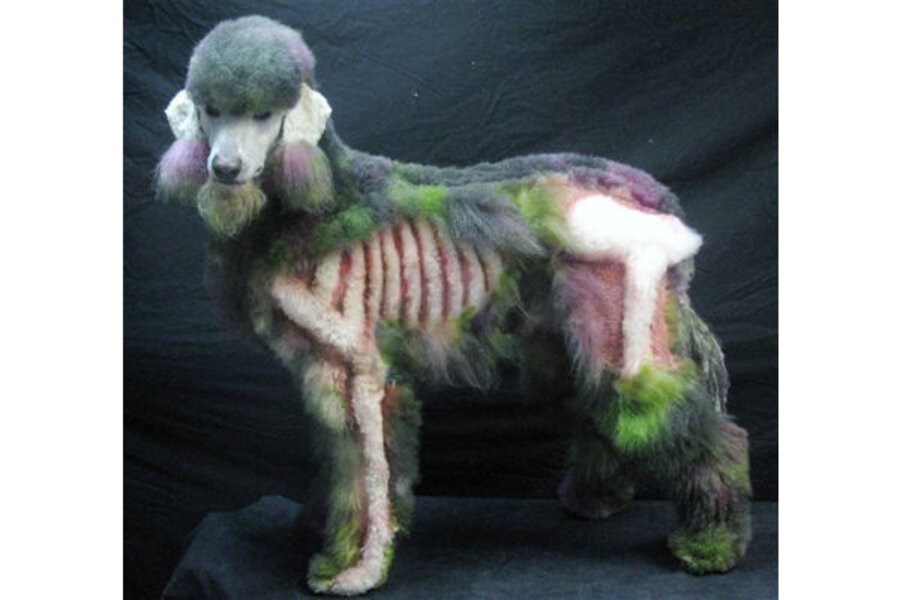Puppy bling: Owners take grooming to new heights
Loading...
| Los Angeles
Sugarplum went into the salon as a reddish-blonde dachshund mix and came out with pink and green ears, a rainbow tail, and a bow in her fur.
"It's like having a little unicorn creature," said Sasha Sinnott, an attorney from Pasadena who was nearly giddy about her dog's makeover.
For some dog owners, simple bathing and combing is not enough. So they pay groomers to turn fur into an artist's canvas, where vibrant sweeps of chalk and paint transform pooches into fantasy fur balls that draw both compliments and strange looks. For an extra 10 or 15 minutes at the groomer, the everyday dog can get an outlandish redesign with a temporary paint tattoo, Mohawk, feather extension, or glued-on jewels.
Then there are the "extreme groomers," who turn their own pets into elaborate creations like zombies, flowers, or even whole jungle scenes, transformations that can take months as hair grows, paint is applied, fur is braided or extended, and shapes are sculpted.
But there are limits to the makeover mania, which is blossoming in an unregulated industry that can leave pets open to risks. Experts say products should be toxic-free and there should be no pain involved – absolutely no piercings or real tattoos. If dogs enjoy being groomed, they shouldn't mind the extra primping, experts added, though one veterinarian said, "It's just something I would not do."
But many pet owners and industry professionals say it's a fun activity that helps person and pooch bond.
"For me, it is about a closer connection with my pets. People are now showering their pets with the amenities and affections that they would like themselves," said Lauren L. Darr, founder of the International Association of Pet Fashion Professionals.
And grooming products are getting more mainstream every day, added Ms. Darr, author of the Pet Fashion 2014 Almanac.
But a big worry for the average pet owner is a grooming industry unfettered by regulations, said Amy Bullet Brown, founder and president of the National Association of Professional Creative Groomers LLC and the owner of an Alabama dog spa.
"If a groomer wants to bathe your dog in battery acid, he can, and it's going to die, but it's not against the law," she said.
Some groomers use bleach and oxidizing dyes on pets, Ms. Brown said. Neither should be used on animal skin, which is much more susceptible to toxic chemicals than human skin, she said.
Creative grooming can be fun, but it is cosmetic only. If there is any danger, like sharp instruments, it should not be done, Brown said.
To help keep pets safe, ask a friend or a veterinarian to recommend a good groomer.
Brown is one of the "extreme groomers." The fad has become a sport of sorts – more than a dozen U.S. competitions are held every year.
Some of Brown's most photographed dog work includes a zombie, sculpted over a year to look like exposed bones and rotting flesh, and a tribute to the Alabama football team that took more than four months to make.
For the regular pet owner, birthdays are the most popular occasion for chalk-based makeovers, said Megan Mouser, groomer and PetSmart salon project manager in Phoenix. Sports team colors are also in demand, she said.
At PetSmart, it costs $6 to chalk a dog's ears and $2 for a single streak of color on the coat. After applying a sealer, resembling hair spray, the design can last one to six days.
Two veterinarians had disparate takes on the phenomenon.
Grooming a dog is almost always for the benefit of a person, so if there is no pain and it's fun for all, then "party up," said Dr. Bonnie Beaver, a professor at Texas A&M University's College of Veterinary Medicine and director of the American College of Veterinary Behaviorists.
Her colleague, Dr. Mark Stickney, a clinical associate professor at Texas A&M, said he's never tried anything beyond a Halloween costume on his dogs. Additional grooming "just really is not my kind of thing. It's just something I would not do."
But Eve Adamson of Iowa City, Iowa, says the trend can be beneficial. She is co-author of Animal Planet's "Complete Guide to Dog Grooming" and grooming columnist for the American Kennel Club's Family Dog magazine.
"It cheers the family up to see the pet dressed up, and you get a lot for your money," she said.
The doggie decor likely makes some people think, "That poor pooch, he must be so embarrassed."
But "that's human psyche, not canine psyche," Brown said. "Dogs are not embarrassed by their appearance. They don't care what color they are. If they crave attention, they will love it."







